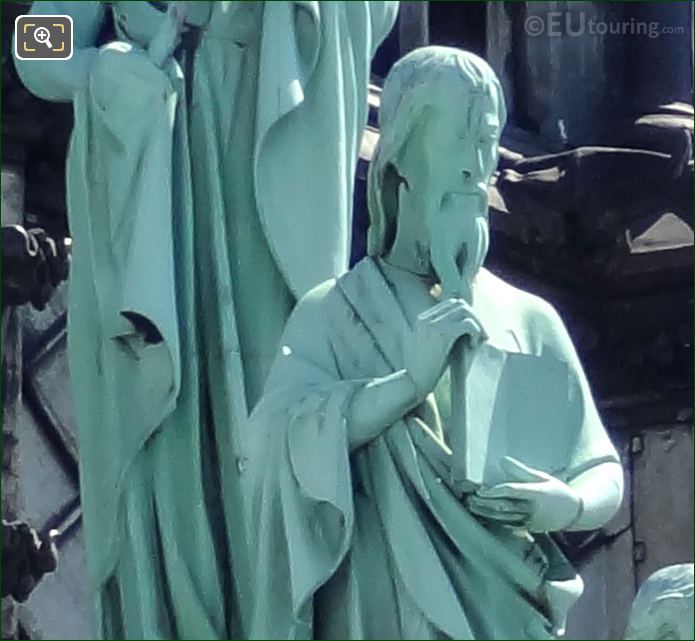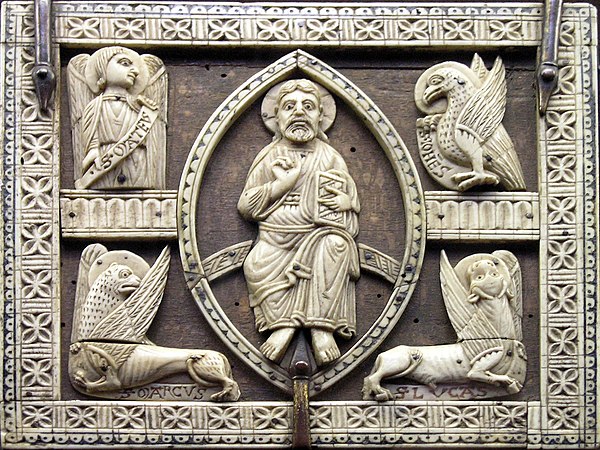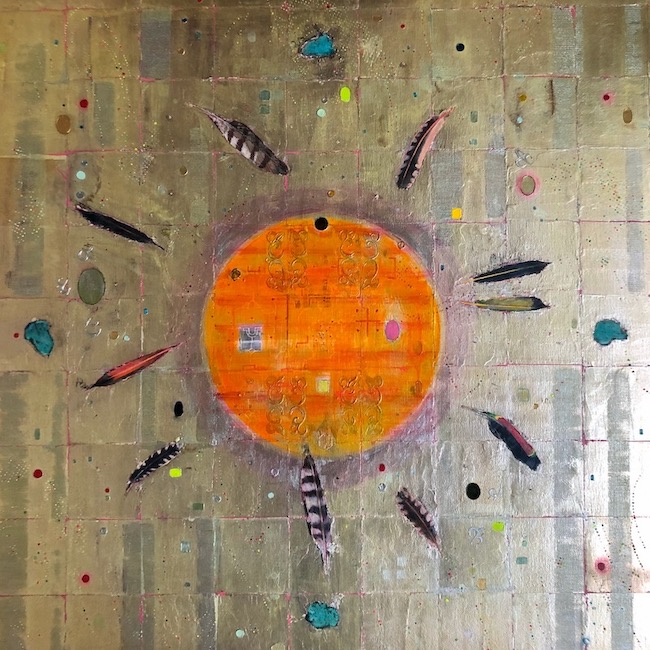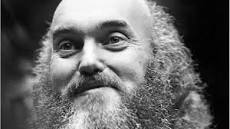
"A little consideration of what takes place around us every day, would show us that a higher law than that of our will, regulates events...." Ralph Waldo Emerson
Twelve apostles flew off the roof of Notre- Dame de Paris a few years ago. Perhaps you recall hearing about the restoration of these larger than life statues. A plan long in the making because each of these complex figures weighs a tremendous amount, originally cast from plaster molds in poured iron and then covered with hammered pieces of copper. There was a pragmatic determination to remove the heads of the figures and then transport the bodies from the roof via cranes and then transport them to the south of France for repair. (In the photo above, note the line at the neck that suggests that the head had been cast separately.)
Four days after the disassembled figures were moved from the roof of the grand cathedral, remarkably, a fire broke out exactly where they had stood:
“It was a beautiful spring day in Paris on April 15th, when tourists walking about the Île de la Cité in the early evening noticed something unusual at Notre-Dame – smoke was wafting above the Cathedral. Word began to spread quickly, and as the gaze of bystanders was drawn to the iconic spire of the landmark, one tourist tweeted at 6:52 p.m., “It appears Notre-Dame is on fire.” ”
~from Tom Brandt, The Tragic Fire at Notre Dame Cathedral
The green guardians of the spire had been moved to safety but the spire was not.
It burst into brilliant orange flames, consumed along with the extensive scaffolding in place around it and crashed down from the roof while onlookers gasped below in disbelief. At 7:50 pm the roof collapsed into the sanctuary below, leaving gaping holes in the ceiling, fire and charred debris dropped through to the cathedral floor. To save the structure from further collapse, some 500 firefighters focused their efforts on saving the twin towers.
Whatever happened to ignite the fire is not known for certain; investigators believe either someone in the scaffolding crews dropped a cigarette, or a spark from the elevator installed for the restoration set off the blaze. An alarm sounded and a newly hired security person, working a second shift, checked the site but missed the actual location. His supervisor did not respond to his call immediately, which delayed the response further. Rapidly, that April evening the fire swallowed the spire and the scaffolding leaving little to examine.
The elegant spire of the cathedral contained relics— teeth, bones or hair — of the patron saints of Paris, St. Denis and St. Geneviève. The relics were placed in the spire by an archbishop to protect the cathedral.**** Tons of rubble, burnt black beams and lead-based dust had to be removed before any further restoration could take place, but remarkably, the main altar and the large gold cross on the altar remained in tact.
The forest of trees used in the original roof will likely be redesigned to be risk managed and more fire-proof safeguards put in place when completed. Since the fire, Notre- Dame’s signature flying buttresses have been repaired and its enormous rose- patterned stained-glass windows have been sent to contractors for restoration, along with several statues and large 17th and 18th century paintings. **
A (very brief) History of the Spire and Its Statues
Construction of the cathedral began in medieval times, 1163, under Bishop Maurice de Sully and was largely completed by 1260, though it was modified frequently in the centuries that followed. In the 1790s, during the French Revolution, Notre-Dame suffered extensive desecration; much of its original religious imagery was damaged or destroyed.***
The initial spire was supported by a well-designed system of frames and its significant weight anchored on four pillars on the transept, it functioned as a bell tower and held holy relics for the cathedral. In March 1606, the large cross atop the spire fell due to strong winds and degradation, but the spire structure remained on the cathedral until 1792. For several decades afterwards, there was no Gothic spire.
Victor Hugo’s 1831 novel, “Notre-Dame of Paris,” published in English as “The Hunchback of Notre Dame,” educated readers about the building’s decrepit condition. Hugo's book helped to awaken the public sphere to make significant repairs from 1844 to 1864, when the architects Jean-Baptiste-Antoine Lassus and after his death, Eugène-Emmanuel Viollet-le-Duc recreated a new spire made of lead and oak, 315 feet in height, and additionally 16 copper statues of the disciples and four winged ones, around its base.
Symbolic Meaning
At the time of the 2019 fire, Notre-Dame was certainly one of the most famous cathedrals in Europe and drew in about 13 million visitors each year. Notre-Dame, meaning Our Lady, was built on a small island called the Île de la Cité, in the middle of the Seine, it was and continues to be considered a crown jewel of medieval Gothic architecture.
The removal of cathedral's roof statues seemed a practical decision for restoration, but only after a recent conversation with someone, was I inspired to consider the story from a symbolic perspective. One-by-one with a holy wind under their patinated robes the statues descended to the earthly realms. Once the apostles left their medicine wheel of two centuries, guarding the parameter of the roof and the spire, in the pattern of the four directions-- through rain, snow, sleet and hail-- silently, fixed and firm, something shifted. Could it be that the energy of their formation-- copper is a high electrical conductor-- set something in motion energetically when they were moved?
All depictions of male figures and/or symbolic images of them, guardians of the holy grail, (if you follow the meaning of the grail as Jesus’ blood-line, as an analogy or something else*) departed the roof of Notre Dame, sans heads and four days later the historic nine centuries old cathedral burst into flames! Dream Master teacher and writer, Robert Moss, after a lifetime of dream study, claims that one might consider dreams more real and everyday existence more symbolic. With that in mind, could the unexpected fire be viewed as a mark of change in the world in general and in Christianity specifically? A burning bush of our times?
The statues embody the essence of the sacred circle surrounding Christ Jesus during his lifetime. They were stationed around the spire in four groups of three plus four additional figures symbolizing the Four Evangelists, Matthew, Mark, Luke and John-all looking down over Paris except for the figure of St. Thomas who was portrayed looking up at the spire with a face patterned after the designer, Eugène-Emmanuel Viollet-le-Duc. From a shamanic perspective, a medicine wheel holds space, sacred space and the attributes of the four primary directions. This archetype is a living mutable medicine that one can connect to at any time.
The Tetramorph
Each of the four sections of the roof had a row of three Apostles, standing one behind the other and staggered by elevatioin above one another. In front of each grouping was another statue, a tetramorph: the bull for St. Luke, the lion for St. Mark, the eagle for St. John and the angel for St. Matthew. Each grouping faced one of the four cardinal directions. A tetramorph is a symbolic arrangement of four differing elements, or the combination of four disparate elements in one unit. The word tetramorph is derived from the Greek tetra, meaning four, and morph, meaning shape.
In Christian art, the tetramorph is the union of the symbols of the Four Evangelists, derived from the four living creatures in the Old Testament, Book of Ezekiel, into a single figure or, more commonly, a group of four figures. The most common association, but not the original or only, is: Matthew the man, Mark the lion, Luke the ox, and John the eagle. In Christian art and iconography, Evangelist portraits are often accompanied by these tetramorphs, or the symbols alone used to represent them. Evangelist portraits that depict them in their human forms are often accompanied by their symbolic creatures, and Christ is often depicted surrounded by the four symbols.***
The Book of Ezekiel speaks of a strange vision, difficult to interpret: “Each had four faces, and each of them had four wings. ….Each had the face of a man in front, the four had the face of a lion on the right side, an ox on the left side and the face of an eagle at the back. Such were their faces.” One might also think of this description as a medicine wheel with the faces representing the four directions. Or perhaps the arrangement of the constellations in the heavens.
The Christian tetramorph originated in the Babylonian symbols of the four fixed signs of the zodiac: the ox representing the constellation of Taurus; the lion representing the sign Leo; the eagle representing Scorpio and the figure of a man or an angel representing Aquarius. Scorpio is connected to the Eagle, and also the Phoenix. These four fixed signs fall in the middle of each season. Astrologers say, fixed signs are gates of power! They are known as the workhorses of the zodiac. In Western astrology the four fixed signs are associated with the elements of, respectively, Earth/Ox/Taurus/St. Luke, Fire/Lion/Leo/St. Mark, Water/Eagle/Scorpio/St. John, and Air/Angel/Aquarius/St. Matthew. All of the four elements were present on the day of the fire: Earth, Air, Fire and finally, quenching Water.
The figures of the Christian tetramorphs were also common in Egyptian, Greek, and Assyrian mythological stories and sculptural reliefs. The early Christians adopted this symbolism and adapted it for the four Evangelists, which first appear in Christian art in the 5th century, but whose interpretative origin stems from Irenaeus in the 2nd century. (See Note 1). Is this assembly of God disassembled, revealing a larger shift? If so, the sacred light of the fire consuming the spire after the apostle statues were removed, is a theophany, or Divinity for all to see. The appearance of Our Lady in a form that is visible and sends a message.
Fire is a release of the old. Perhaps Our Lady is communicating, it is time to transform and reset to a higher expression of living.

(Video footage of 2019 Notre-Dame fire can be found online at the NYTimes.com).
Notre-Dame on Fire:
A film by Jean-Jacques Annaud, with Samuel Labarthe, Jean-Paul Bordes, Mikael Chirinian, Jérémie Laheurte, Chloé Jouannet and Pierre Lottin
References from:
Online eutouring.com
Quotation fromTom Brandt: The Tragic Fire at Notre- Dame Cathedral
*By analogy, any elusive object or goal of great significance may be perceived as a holy grail by those seeking it.
** Notes from Friends of Notre- Dame de Paris
***Notes from Wikipedia
****https://www.nytimes.com/2019/04/15/world/europe/notre-dame-cathedral-facts.html
- See Wikipedia on Irenaeus (/ɪrɪˈneɪəs/; Greek: Εἰρηναῖος Eirēnaios; c. 130 – c. 202 AD)[3] was a Greek bishop noted for his role in guiding and expanding Christian communities in the southern regions of present-day France and, more widely, for the development of Christian theology by combating heresy and defining orthodoxy. Originating from Smyrna, he had seen and heard the preaching of Polycarp, who in turn was said to have heard John the Evangelist, and thus was the last-known living connection with the Apostles.
 Thursday, May 29, 2025 at 01:19PM
Thursday, May 29, 2025 at 01:19PM 
 Deborah Gavel |
Deborah Gavel |  Post a Comment |
Post a Comment | 


